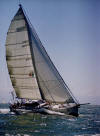|
The Cutter Rig We read all of the Dashew material, as you probably have, before choosing to buy a Sundeer 64, and we definitely wanted one with a ketch rig. But the only ketches available were in poor condition, so Pete Bollman of Bollman Yachts found Raven for us and convincingly explained that a cutter rig was a better idea for most cruisers anyway. He claimed the rig is much simpler to handle and the big bonus is a bimini to shade the cockpit while at anchor and at sea. At the time, the bimini part sounded trivial, but after sailing 15,000 miles mostly in the tropics we can confirm that Pete was right on all counts. In addition, we found that haulouts are simpler since at most we have to loosen the forestays to accommodate the Travelift; friends who own a Sundeer ketch often have to pull their mizzen mast in the same situation. Steve Dashew loves fast passages, and a ketch lets him carry more sail area. Like most cruisers we know, we prefer to go fast but we also like our comfort, especially at sea. For example, read about the Teschke family's circumnavigation aboard their Sundeer 64 in the Dashews' Offshore Cruising Encyclopedia, and how they preferred much smaller sail combinations than Steve uses. Here is how we sail Raven: Downwind and Reaching
Sailing dead downwind is rarely a speedy idea in a modern sailboat, including a Sundeer. We have found that Raven's optimum downwind performance in the usual South Pacific trades (15 to 18 knots true wind speed) comes at an apparent wind angle of about 120 degrees, which usually results in a true wind angle of 145 degrees. She seems happy at those angles and speeds under either reacher or cruising spinnaker ― the chute is especially helpful at lower wind speeds. Passagemaking Our usual reaching-to-downwind passagemaking setup, when the winds are moderate (15-25 knots), is to hoist the mainsail with one reef and to use the three roller furling headsails to vary our sail area over a wide range. In lighter airs, with the reacher we set a total of more than 2,100 sq.ft. of sail, even with the main reefed. Furl the reacher and roll out the jib, and our sail area drops to about 1,500 sq.ft. And with the single-reefed main and the staysail we set only about 1,000 sq.ft. This tactic allows us a huge range of speed potential without ever leaving the cockpit, since all three headsails furl using the small electric Lewmar next to the helm. When the breezes are lighter, we have only to shake out the single reef in the main and then decide if we want to have a little fun and set the chute, or be lazy and stick with the reacher. Upwind
When the destination is dead upwind, Raven's best sail combination is "the VDS and the 140-percent Yanmar". Our "VDS" (Vertical Dacron Stabilizer) is the mainsail with a single reef strapped down tight, and the "140-percent" Yanmar" is our faithful 140-horse diesel set at moderate RPMs. While everyone else is slogging over the waves and sagging off to leeward, we head about 12 degrees off the wind and just power into it, making seven knots or better VMG. Fuel economy is excellent ― 1 or 2 gallons an hour ― if there's even a little bit of breeze. We always get there hours or days before the others. Reefing Another smart Dashew touch, slightly modified by us, is Raven's reefing system. Whether heading upwind or down, reefing is easy and quick, with no requirement to head into the wind to ease the strain. We have reefed in 35 knots while broad reaching without touching the autopilot heading.
Yes, we've had some wonderful cruises aboard Raven, and we do hate to sell her. We can only hope that another family will love her as much as we do. Jan & Signe |
.jpg)
_small.jpg)



